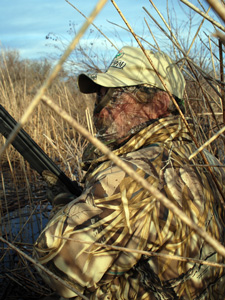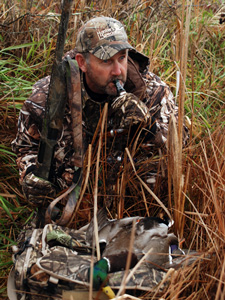
If you've ever sat in a duck blind late in the season, when most of the mallards have already migrated further south, the weather is the worst of the winter and what ducks you do see are hunter smart and call shy, you need to regroup and adapt to a handful of tactics that will improve your late-season duck hunting odds.
 |
| Utilizing natural concealment in seldom hunted places is a great late-season tactic for mallards. |
Experienced duck hunters learn the hard way that knowing where the ducks are reduces the frustration level when it's time to hunt. Hunters are at the mercy of Mother Nature. Cold snaps can push ducks down from the north by the tens of thousands while freeze-ups can push the same ducks that were here today out of the region tomorrow.
"Watching the weather is crucial to planning successful duck hunts," said avid waterfowl hunter Perry May. "I watch the weather channel daily and check the waterfowl migration status on DU's website, www.ducks.org. I also check the Upper/Lower Mississippi River Waterfowl Aerial Surveys to keep me abreast of waterfowl migrations. "Bad weather and bird movements go hand in hand. I can have thousands of birds one day and none the next, if ice and snow arrive."
Scouting plays a key role in late season waterfowl hunting as well. "Assuming that ducks will continue to use the same areas all season is a common mistake among duck hunters," says Barnie Calef, a waterfowl expert for Hunter's Specialties. "Sure guys like to use the permanent blinds that they've built. However, birds may not work that area all season. Being flexible enough to move around or move to a new area entirely may make the difference in a good day and a bad day. Too much hunting pressure and depletion of food sources will make ducks leave an area. Continuing to scout new areas, especially later in the season, is insurance for success."
Just as humans prefer steak over cold cuts, ducks have food preferences as well and will seek out what they prefer most as long as weather and hunting pressure allow. If either variable falters, ducks will move out of the area. However, the move sometimes may not be a long one. Checking out-of-the-way places that are hidden or tucked away in hard to get to places can pay big dividends. One of the finest late-season mallard hunts I ever enjoyed took place on a small 2-acre willow swamp less than a quarter mile from a major interstate highway. Duck hunters had been hunting the birds hard in nearby rice fields. Both the food supply and the birds' tolerance for hunters had dwindled rapidly. The small willow swamp provided a resting and feeding place for the hungry, tired birds.
 |
| Wading into out-of-the-way places that are hard to reach is a great way to find unpressured late-season ducks. |
Flexibility and the willingness to try something new are two good tools for the late-season waterfowler as well. Often times duck hunters' desires are best met by making a major move, even to another state. Weather, migratory urges and hunting pressure all play a role in the annual odyssey of waterfowl migrations. A couple of seasons ago my hunting opportunities for mallards had pretty much fizzled out in central Missouri. I received a call from James Wald of Geary, Okla. "Bill, the mallards are here," he had said. "You need to come down."
I had never waterfowl hunted in Oklahoma. The operation Wald ran focused on wild hogs. Hogs and ducks didn't seem to mix. Giving him the benefit of the doubt, I did a web search about duck hunting in Oklahoma. As it turned out, several major waterways course their way through the state. Ducks of the Central Flyway navigate their way south via these riparian courses. Wald's operation bordered the South Canadian River, which was surrounded by nearby peanut fields. We set a date for mid-January.
I immediately realized I had arrived in duck hunting heaven when I met guides Jeremy Budgick and Bryan Thomas, the owners of Racks and Quacks Customs Calls. The youthful pair bubbled with excitement as they explained their hunting plan. "We have an afternoon hunt planned, Jeremy began. "We will be hunting a tough spot to get to. Our party will have to wade into a remote willow swamp for about 150 yards. Most of the water is knee-deep, but there are a few spots where caution is in order. A few holes we have to cross will be better than waist deep. It's a real sweet spot. Ducks leave the peanut fields beginning about 3 p.m. They head to the swamps to hide, rest, loaf, feed some more and roost. You'll enjoy the sunset."
His words rang through my head — remote, swamp, leave fields, hide, rest — we were about to experience the best of late-season mallard hunting.
Good friend Mark Oestrich joined the hunt. We traveled light in order to negotiate the hazards of the swamp. "We look like a jungle patrol in 'Nam," Oestrich remarked. Memories flooded both of our minds.
 |
| Late-season calling tactics should include a single-reed timber call and soft calling. |
Oestrich and I must have been shorter than the guides. Cold water lapped at the tip of our waders a time or two, but we were determined to reach our destination.
Bryan Thomas directed us to wide boards sitting atop concrete blocks. "Sit here, you two," Thomas instructed. "All natural blinds here, boys. The swamp has not been hunted this year and the ducks are very comfortable here."
"Element of surprise," Col. Oestrich whispered with a grin. Our party of four hunters settled onto the benches in anticipation of what was to come.
Budgick and Thomas both wore lanyards of duck calls around their necks and had begun playing with them. They had talked at length the night before about choosing the right duck call for the right situation. Budgick had noted that novice callers generally begin with a double-reed call because they are easier to blow and produce a lot of volume. "Single-reed calls produce more natural sound, however," said Budgick, "and they are good for close-in situations like these willow swamps. They're often referred to as timber calls."
We had no more than become comfortable when a great flight of ducks darkened the sky to the west. "Mallards poured in here yesterday afternoon," Thomas whispered. "You guys are in for one good late-season hunt."
Wave after wave of ducks appeared on the horizon. "Many of the flocks are going down in swamps to our north," Wald advised. "It won't be long until they will begin filtering into our area."
Moments later a lone mallard zoomed in from behind Oestrich and me. Mark took a snap shot, and the first mallard of the day tumbled to the swamps. "Wow, great shot," I congratulated.
 |
| The results of a well-planned and executed late-season mallard hunt. |
I questioned the guides' soft calling tactics. "All we need to do is let them know there are other ducks here. Our few decoys and a few hail calls prompted the first birds to drop in," Budgick said. "Now that they are coming, soft quacks and a few short runs is all we need. You gotta remember that these ducks have been called to and shot at for the last two months," Thomas chided.
I couldn't help but marvel at the wisdom of these two young duck guides as flight after flight of mallards arrived from the peanut fields. Our guides had done their homework. They had scouted, changed tactics and moved from the fields where most hunters were spending their time to the sure-fired place the ducks wanted to be — in a remote swamp where they could feed, hide and rest.
I had been skeptical of hunting ducks on the Canadian River. Most Oklahoma duck hunters spend their time on the big Lakes like Grand, Eufala and Kaw and areas such as the 7,000-acre Hackberry Flats Wildlife Management Area. They all provide excellent waterfowling, but it was late season. We were enjoying a hunt in a remote area where the ducks wanted to be. We enjoyed a mallard hunt under total natural conditions rather than compete with other hunters on crowded areas. The birds responded magically to only one set of decoys and one trio of callers — a duck hunters dream come true.
As the sun began to slink behind the western horizon, I marveled at the sight of thousands of mallards dropping out of darkening skies. Few flared at the gunshots. They wanted to rest.
Guide James Wald called shooting hours. All of his late-season tactics had worked like a charm. We sat in the swamp a few minutes longer, relishing the growing scene as hordes of mallards plopped down at our very feet.
- 8560 views

